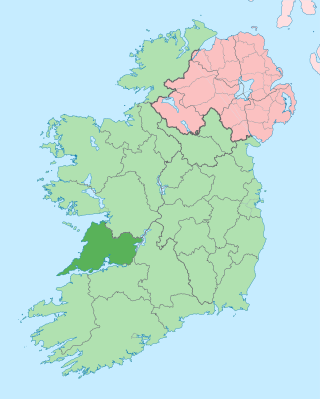County Down was a UK Parliament constituency in Ireland. It was a two-member constituency and existed in two periods, 1801–1885 and 1922–1950.

County Clare was a parliamentary constituency in Ireland, represented in the Parliament of the United Kingdom. From 1801 to 1885 it returned two Members of Parliament (MPs) to the House of Commons of the United Kingdom of Great Britain and Ireland.

County Dublin was a parliamentary constituency in Ireland, which returned two Members of Parliament (MPs) to the House of Commons of the Parliament of the United Kingdom.
County Kilkenny was a former UK Parliament county constituency in County Kilkenny in Ireland. The County constituency returned two Members of Parliaments (MPs) in the House of Commons of the United Kingdom of Great Britain and Ireland, from 1801 until 1885.
County Tipperary was a parliamentary constituency in Ireland, which from 1801 to 1885 returned two Members of Parliament (MPs) to the House of Commons of the United Kingdom.

County Waterford was a parliamentary constituency in Ireland, represented in the British House of Commons.
Cork City was a parliamentary constituency in Ireland, represented in the Parliament of the United Kingdom. From 1880 to 1922 it returned two members of parliament (MPs) to the House of Commons of the United Kingdom of Great Britain and Ireland. From 1922 it was not represented in the UK Parliament, as it was no longer in the UK.
Armagh was an Irish constituency in the House of Commons of the United Kingdom from 1801 to 1885.
Athlone was a parliamentary constituency in Ireland, which from 1801 to 1885 returned one Member of Parliament (MP) to the House of Commons of the United Kingdom of Great Britain and Ireland.
Cashel is a former British Parliament constituency in Ireland, returning one MP. It was an original constituency represented in Parliament when the Union of Great Britain and Ireland took effect on 1 January 1801.
Drogheda was a parliamentary borough constituency in Ireland, which returned one Member of Parliament (MP) to the House of Commons of the Parliament of the United Kingdom. It was an original constituency represented in Parliament when the Union of Great Britain and Ireland took effect on 1 January 1801, replacing the Drogheda constituency in the Irish House of Commons.
Dundalk was a parliamentary borough constituency in Ireland, which returned one Member of Parliament (MP) to the House of Commons of the Parliament of the United Kingdom. It was an original constituency represented in Parliament when the Union of Great Britain and Ireland took effect on 1 January 1801, replacing the Dundalk constituency in the Parliament of Ireland.
Ennis is a former United Kingdom Parliament constituency in Ireland, returning one MP. It was an original constituency represented in Parliament when the Union of Great Britain and Ireland took effect on 1 January 1801.
Wexford Borough was a United Kingdom Parliament constituency, in Ireland, returning one Member of Parliament (MP). It was an original constituency represented in Parliament when the Union of Great Britain and Ireland took effect on 1 January 1801.
Mallow was a United Kingdom Parliament constituency in Ireland, returning one MP. It was an original constituency represented in Parliament when the Union of Great Britain and Ireland took effect on 1 January 1801. The constituency lasted until 1885 when it was absorbed into the North East Cork constituency.
Kinsale was a United Kingdom Parliament constituency in Ireland, returning one MP. It was an original constituency represented in Parliament when the Union of Great Britain and Ireland took effect on 1 January 1801.
Kilkenny City was an Irish borough constituency in the House of Commons of the United Kingdom of Great Britain and Ireland, returning one Member of Parliament (MP). It was an original constituency represented in Parliament when the Union of Great Britain and Ireland took effect on 1 January 1801, and remained in existence until its abolition at the 1918 general election.
Galway Borough was a United Kingdom Parliament constituency in Ireland. It returned one MP from 1801 to 1832, two MPs from 1832 to 1885 and one MP from 1885 to 1918. It was an original constituency represented in Parliament when the Union of Great Britain and Ireland took effect on 1 January 1801.
Belfast was an Irish borough constituency in the House of Commons of the United Kingdom of Great Britain and Ireland. Comprising the city of Belfast, it elected one Member of Parliament (MP) from 1801 to 1832, and then two MPs from 1832 until the constituency was divided by the Redistribution of Seats Act 1885 for the 1885 general election.


